Honduran women carrying water from the river for cooking and cleaning
Saturday we took a day trip to Tela. Tela is on the coast, normally about an hour's drive from La Ceiba.
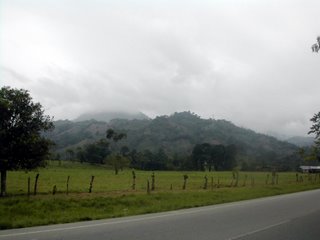 The highway runs east and west and winds around the mountains and passes through miles of pineapple fields, palm tree plantations (grown for palm oil), banana fields, and a few small towns. On the south side of the highway, you will see mountains, on the north (sea) side, the terrain is relatively flat.
The highway runs east and west and winds around the mountains and passes through miles of pineapple fields, palm tree plantations (grown for palm oil), banana fields, and a few small towns. On the south side of the highway, you will see mountains, on the north (sea) side, the terrain is relatively flat.It's a picturesque drive during the day. It can be dangerous at night due to the curving roads, speeding buses, and vehicles driving without lights (many more than you might think). Even during the day, you have to constantly watch out for the trucks and buses passing on blind curves.
 There wasn't so much traffic this time. We took it slow and actually spent a fair share of time driving backwards after I would yell, "Stop! I want to take a picture of that."
There wasn't so much traffic this time. We took it slow and actually spent a fair share of time driving backwards after I would yell, "Stop! I want to take a picture of that."The north coast of Honduras has what are called 'cloud forests' versus 'rain forests. This picture shows how the mountains disappear in the clouds.
We stopped along the way several times to take pictures for you. I have to apologize for the quality. Besides being a dark and dismal day, my camera zoom is broken so all I can get is wide angle views. You can click on the photos to make them larger. Anyway, here you go:
 Cacao (cocoa seeds) are often dried on the edge of the highway.
Cacao (cocoa seeds) are often dried on the edge of the highway. You probably can't see how skinny these cattle are. The cows in Honduras usually have visible ribs and hip bones sticking out.
You probably can't see how skinny these cattle are. The cows in Honduras usually have visible ribs and hip bones sticking out.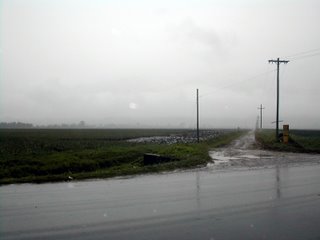 This is a pineapple field. The mountains in the background aren't visible because of the clouds. East of La Ceiba, there are miles and miles of pineapple fields. As you get closer to Tela, you see more palm and banana fields along the highway.
This is a pineapple field. The mountains in the background aren't visible because of the clouds. East of La Ceiba, there are miles and miles of pineapple fields. As you get closer to Tela, you see more palm and banana fields along the highway. The picture on the right shows our bright orange laterite soil. It also shows how the trash is thrown along the roadsides.
The picture on the right shows our bright orange laterite soil. It also shows how the trash is thrown along the roadsides.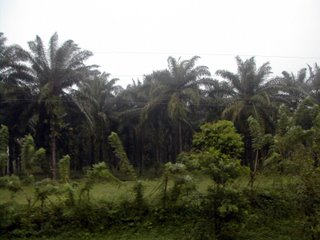 On the left is an African palm plantation. I wanted to show the variety of plants that grow on the palm trunks but it's too dark. The fence posts in front are made of fresh wood − because of the tropical climate, the wood roots and sprouts into trees. Sometimes the trees are allowed to grow, but most often they are hacked back into fence posts with a machete.
On the left is an African palm plantation. I wanted to show the variety of plants that grow on the palm trunks but it's too dark. The fence posts in front are made of fresh wood − because of the tropical climate, the wood roots and sprouts into trees. Sometimes the trees are allowed to grow, but most often they are hacked back into fence posts with a machete. This is a banana field. The bananas are mulched with something. I can't tell what it is. We mulch ours with spent banana leaves. These banana plants appear to have suffered from lack of water before the recent rains.
This is a banana field. The bananas are mulched with something. I can't tell what it is. We mulch ours with spent banana leaves. These banana plants appear to have suffered from lack of water before the recent rains.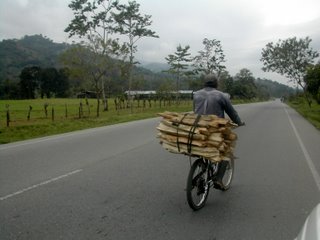 You never know what you'll see on the highway. Bicycles are a common form of transportation along the coast. This wood is used for cooking. Many families have only a firepit or homemade stove for cooking. We saw many piles of leña (firewood) for sale along the highway.
You never know what you'll see on the highway. Bicycles are a common form of transportation along the coast. This wood is used for cooking. Many families have only a firepit or homemade stove for cooking. We saw many piles of leña (firewood) for sale along the highway. This is another African palm plantation in the distance with the mountains behind. Big clusters of seeds grow on the trunk of the palm trees. They are processed into palm oil for use in this country as well as for exportation.
This is another African palm plantation in the distance with the mountains behind. Big clusters of seeds grow on the trunk of the palm trees. They are processed into palm oil for use in this country as well as for exportation.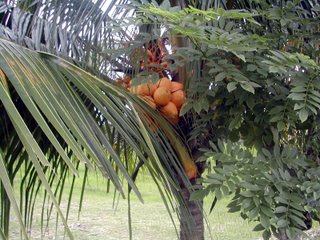 On the left is a closeup of some yellow coconuts.
On the left is a closeup of some yellow coconuts. This is a house made out of sticks and clay soil with a roof of palm fronds. The picture includes the obligatory cute barefoot kid in the doorway. She smiled and waved at us. This house has a wood door. I've seen many others that only have a curtain.
This is a house made out of sticks and clay soil with a roof of palm fronds. The picture includes the obligatory cute barefoot kid in the doorway. She smiled and waved at us. This house has a wood door. I've seen many others that only have a curtain.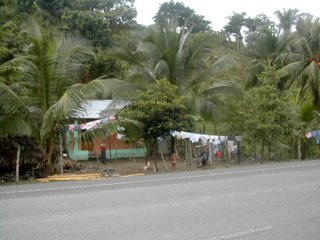 On the right is a typical small concrete house. If you look closely you can see a white tailless rooster almost the size of the small child. The big palms are coconuts.
On the right is a typical small concrete house. If you look closely you can see a white tailless rooster almost the size of the small child. The big palms are coconuts.This house is probably two rooms, a living/cooking area and a bedroom. The door is raised up above ground level so it is likely that this house has a concrete floor, as opposed to the houses in the pictures above and below which no doubt have only dirt floors.
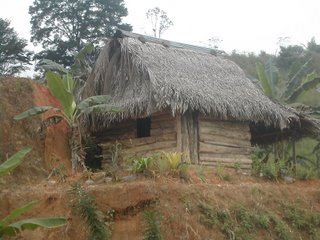 This picture shows a very small wooden house with a palm frond roof. It sits just off the highway on a little cliff that has been dug into the hill. Even though they don't have much space, they are growing bananas and have planted some ornamental plants around the house.
This picture shows a very small wooden house with a palm frond roof. It sits just off the highway on a little cliff that has been dug into the hill. Even though they don't have much space, they are growing bananas and have planted some ornamental plants around the house.This type of house is often built by invasionistas (those who invade the property of others and build a house). Sometimes whole communities are built this way. It's not at all unusual to see houses built of bits of wood, tin, cardboard, and plastic tarps. Depending upon who owns the property (i.e., how influential they are), the police or army may come and knock down all the houses. That happened recently in La Ceiba, where dozens of families were put out of their homes to make way for a new colonia (neighborhood).
Tomorrow I'll show you some pictures from Tela, Honduras.

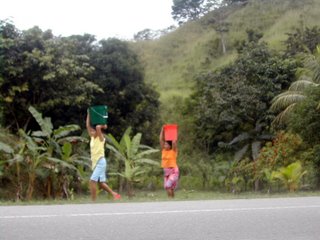

 Welcome to my Blogicito —
Welcome to my Blogicito — 







